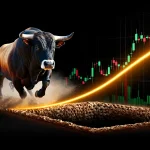
A Sudden Shift That Challenges Assumptions
Dec 26, 2024
What if every stock forecast and market tip you trusted was fueled by hidden biases rather than logic? Picture the dot-com frenzy of the late 1990s. Newly minted day traders believed they had discovered a path to easy riches, fueled by bold headlines and office chatter about once-obscure tech startups. Share prices surged, and more people piled in, convinced that these gains were unstoppable. Then came the crash. A sudden burst of panic replaced blind optimism, wiping out fortunes overnight.
This episode highlights the power of behavioural finance in shaping trading decisions. Even the most rational participants can succumb to temptation when charts keep heading north and news outlets hype “can’t-miss” opportunities. Experts in psychology, such as Daniel Kahneman, have pointed out that individuals rarely make decisions based purely on logic. Instead, biases like overconfidence, anchoring, and herd behaviour lead them astray, especially during extreme market exuberance or deep fear.
Consider the 2008 housing crisis. Investors hinged their hopes on the belief that real estate would never crash. That unshakable faith led banks to package questionable mortgages as high-quality investments, and many borrowed heavily against their presumed equity. When housing values plummeted, chaos erupted. Here again, baked-in biases played a role. Homebuyers believed they were entitled to quick riches, forgetting that any asset can fall swiftly when reality catches up.
Such shocks, whether in dot-com shares or housing, remind us how easy it is to overlook signs of danger. Fear or excitement can stifle our ability to ask uneasy questions. Was that surge in stock price backed by genuine growth or a speculative mania? Was a lender’s mortgage assessment truly grounded or swayed by the belief that prices had nowhere to go but up? By exploring these events, we see how behavioural finance examples shape strategies—for better or worse. Market participants who learn from these missteps can gain an advantage, avoiding the pitfalls of unexamined biases while capitalizing on opportunities when the crowd swings from greedy highs to panic-stricken lows.
Mass Psychology: Why Markets Reflect More Than Fundamentals
In theory, a stock’s price should mirror its intrinsic worth. In practice, perception often trumps logic. When everyone believes an asset will keep rising, that belief can become self-fulfilling until reality intervenes. Behavioural finance examples show how group sentiment can amplify both rallies and crashes. Traders watching tickers move steadily upward experience “FOMO” (fear of missing out), pushing them to buy at almost any valuation. Conversely, a sudden sell-off feels like a bottomless pit, prompting exits at fire-sale prices even if the asset remains sound.
One hallmark of mass psychology is herd mentality. Investors frequently follow popular consensus, forgetting that markets can reverse. During the height of the dot-com bubble, employees quit their jobs to trade tech stocks, trusting the rumour mill and ignoring fundamental red flags. Similarly, before 2008, many assumed that real estate was a one-way ticket to wealth. That groupthink shattered when mortgages defaulted on a large scale, flooding housing inventories and crushing consumer confidence.
Such examples highlight how shared optimism can quickly morph into dread. Robert Shiller, a Nobel Prize-winning economist, underscored how “narratives” drive collective behaviour. Rising prices inspire glowing stories, which attract more buyers. But when negative news emerges—such as a major bankruptcy—those upbeat tales crumble into pessimism. This momentum-based cycle affects casual traders and professionals who feel pressured to keep pace with market sentiment.
Mass psychology also surfaces in data patterns. Technical indicators like volume spikes, stalling rallies, or abrupt plunges reflect shifts in sentiment as the crowd rushes to adopt a new storyline. A trader who knows how to interpret these signals can anticipate trend reversals. However, even the best tools can fail if the user is blinded by the same biases as everyone else. Skipping proper analysis or discipline can lead to disastrous entries and exits. True success requires respecting the part that collective emotion plays in price formation without succumbing to that emotion on a personal level.
Behavioral Finance and the Art of Timing
Have you ever wondered why some investors appear as fortune-tellers, buying at market bottoms or selling just before a slump? Part of that magic stems from understanding behavioural finance. Instead of chasing momentum when crowds are euphoric, these contrarians watch for moments when herd psychology hits an extreme. They sell into strength or buy when fear has pushed prices too low.
Behavioral finance is not merely a theoretical pursuit. Nobel laureate Daniel Kahneman showed how human thinking is riddled with shortcuts, known as heuristics. These shortcuts can lead to misjudgments such as anchoring on a recent price, recency bias, or confirmation bias. For instance, after a phase of robust gains, traders commonly assume the trend will continue indefinitely. The dot-com fiasco exemplified that trap—rapid price surges led people to ignore unsustainable price-to-earnings ratios or negative cash flows.
On the opposite side, once markets crash, negative sentiment can linger long after valuations have turned appealing. Humans exhibit the “snake bite effect,” reacting cautiously after a painful shock. But that mindset can hinder a well-timed reentry during a period of depressed prices. Behavioural finance underscores that success often requires acting against the prevailing mood—selling when everyone else is partying and buying when gloom is widespread.
Studies by Richard Thaler and other experts reinforce that even seasoned traders fall into these traps without proper checks. That’s where discipline and rules-based investing come in. Individuals who identify target numbers for profit-taking and set stop-loss orders can curb impulsive decisions. Behavioural examples underscore the role of clarity in uncertain times. Rather than riding trends blindly, the best strategies blend fundamental data, technical signals, and a healthy scepticism of the crowd’s attitude. Recognizing bias helps a trader avoid chasing illusions, and seizing calculated opportunities can reshape not only portfolios but also a person’s long-term outlook on risk and reward.
Technical Analysis: Uncovering Clues Behind Investor Emotions
For centuries, market watchers have tried to quantify the psychology of crowds using charts and indicators. When you see a chart forming a pattern like “head and shoulders” or moving averages crossing, it’s not magic. These patterns emerge because human motives often repeat. A sudden drop in volume or a bearish divergence on the RSI can flag a slowdown in buying momentum, despite outward excitement. Conversely, bullish divergences can signal that a battered asset is set for an upturn.
Consider the 2008 meltdown in more detail. Technical signals hinted at mounting stress in financial stocks well before the full-blown crisis. Banks began underperforming, volume on down days outpaced up days, and certain leading indicators pointed to a looming shift. While fundamentals eventually revealed the ugly state of mortgage-backed securities, technical charts captured the early shockwaves. Those who paid attention might have pared back exposure to vulnerable areas or used protective strategies.
Of course, technical analysis has limits. Indicators can generate misleading signals, especially during fast-moving news events or black swan scenarios. Still, combining charts with a grasp of behavioural finance offers an edge. For example, if popular stock rockets upward on minimal news, watch for a spike in volume or an RSI reading stuck in overbought territory. That imbalance and an obvious mania among retail traders may signal time to secure profits. By contrast, if an asset appears oversold on charts and headlines are universally gloomy, that scenario might point to a buying opportunity.
Technical data is best employed as part of a broader method that respects human unpredictability. At times, individuals fixate on a certain price target or cling to positions purely out of emotional attachment. Chart patterns can reveal that such sentiment is waning. Timing a trade by reading these signals alongside fundamental checks may help avoid emotional whipsaws. Behavioural finance draws attention to the reasons behind price moves, while technical tools supply tangible evidence of those shifts staring back at us from the charts.
Contrarian Thinking: Profiting from Extremes
The dot-com era and the 2008 housing boom underscore one lesson: a meltdown often follows when everyone rushes in the same direction. Contrarian investors specialize in going against the crowd, selling into exuberance and buying in moments of deep pessimism. That approach sounds easy but demands nerves of steel. How does behavioural finance relate to these contrarians’ strategies? It clarifies their rationale: humans tend to misprice assets at extremes, swayed by hype or fear.
An excellent example is Michael Burry, portrayed in “The Big Short.” He recognized that subprime mortgages were fundamentally flawed and built positions betting against them. Public sentiment at the time insisted that home prices would keep climbing. Burry’s logic ran counter to the mainstream, and he endured criticism and some investor backlash before eventually reaping enormous returns. His success hinged on the understanding that herd psychology had gone off track.
Contrarian thinking aligns closely with the cyclical nature of markets. As fear and greed alternate, mass sentiment swings valuations from oversold to overbought. Contrarians wait for these distortions, using data to verify when a popular belief has outrun reality. They might track margin debt levels, sentiment surveys, or the ratio of bullish to bearish analysts. When optimism surges excessively, a wise contrarian trims exposure. If despair resurfaces, they go on the offensive, scooping up bargains.
But caution is warranted: merely opposing the majority doesn’t guarantee profits. The crowd can sustain a mania far longer than expected, and shorting a craze too early can lead to large losses. Contrarians also watch technical signals to identify possible topping or bottoming patterns. Looking at volume patterns, divergence in momentum oscillators, or a spike in volatility can refine their timing. By blending data with awareness of emotional extremes, an investor can avoid being swept up in euphoria or paralyzed by gloom. In essence, contrarians harness the fact that mass psychology frequently overcorrects, aiming to profit from those swings without letting emotion hijack their judgment.
Balancing Emotion and Strategy for Long-Term Gains
Behavioural finance examples reveal one timeless truth: controlling feelings can matter as much as picking good companies or reading charts. Even the best data can’t offset a tendency to chase short-lived booms or flee perfectly viable investments as soon as the headlines grow grim. Traders who acknowledge the role of biases stand a better chance of staying calm amid wild price swings, which can safeguard both their equity and their peace of mind.
One practical step is to define a plan before emotions flare. Decide how much you’ll invest, set stop-loss rules, and pick levels where you’ll take partial profits. When a stock doubles quickly, gratitude for those gains should outweigh greed to wait for triple-digit returns. Similarly, a trailing stop order can keep small pullbacks from morphing into catastrophic losses if sentiment suddenly changes. This approach borrows from both behavioural research—knowing we become irrational under duress—and technical methods that put real numbers behind decisions.
Timing trades around mass mood swings isn’t about clairvoyance. It’s about spotting lopsided sentiment that has driven prices too high or too low. It’s about detecting recurring patterns in human behaviour, whether mania or despair. Rather than letting groupthink steer your moves, you become the observer who notes extremes and responds accordingly. This shift in mindset can transform how you view opportunity. Instead of feeling dismayed by downturns, you might see them as potential entry points. Instead of chasing rallies well past their peak, you might accept that a run-up has gone too far and secured profits.
Finally, a truly balanced method merges self-awareness with research. Each new mania—from cryptocurrency bubbles to niche biotech hype—carries fresh catalysts but the same underlying human impulses. By internalizing what behavioural finance teaches, traders can maintain composure. They know that once hysteria hits a fever pitch, disappointment often follows. They also know that bleak headlines eventually fade when bargains emerge. The result is a more stable path where vigilant decision-making outperforms blind optimism or panic. In that sense, remembering behavioural finance examples can shape trading strategies in a way that fosters steady gains, both financially and psychologically.










